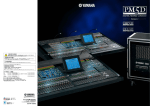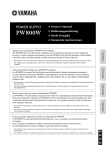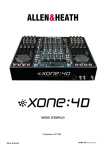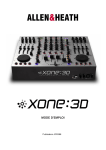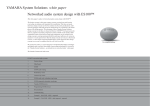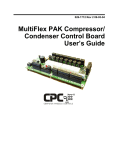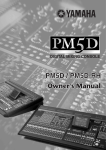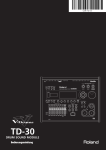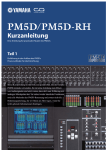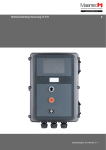Download Yamaha PM5D-RH Specifications
Transcript
For details please contact: www.yamahaproaudio.com This document is printed on chlorine-free (ECF) paper with soy ink. LPA484 Printed in Japan A N ew D i m e n si o n In Digital Live So u nd A lot has changed in the past few years – with more than a little help from Yamaha. Where analog consoles were the only accepted means of handling serious sound reinforcement applications, high-performance digital consoles such as the Yamaha PM1D now share the limelight with their analog brothers such as the PM4000, and more recently the PM5000. Digital consoles are accepted particularly in applications where programmability and recall capability are proving to be of monumental importance. As a small indication of just how much things have changed in the world of professional sound reinforcement, there are more than 400 PM1Ds in use in prestigious halls, broadcast studios, and touring companies around the world (as of March 2004). The accolades keep coming in for other Yamaha digital consoles, too. The fact that the DM2000 digital production console has received both the coveted TEC (Technical Excellence & Creativity) award and the MIPA (Musikmesse International Press Award) for “best sound reinforcement console” indicates how much people have come to embrace the benefits of digital technology. The PM5D series Digital Mixing Consoles and PM5D-RH Digital Mixing Consoles now take the digital revolution to the next level. They are smaller relatives of PM1D, offering state-of-the-art digital performance for a significantly broader range of SR applications that require a more dedicated control surface than the DM2000. What’s more, they offer a system solution that can enhance the entire sound production process from input to output through integration with digital systems such as DME64N and AD8HR. PM5D - a new dimension in digital live sound has begun. LIVE/SR, INSTALLATION Analog Digital BROADCAST PRODUCTION Post Production Audio for Video Music Recording Project Studio PM1D Large Format PM5D PM5000 PM5D/PM5D-RH PM3500 DM2000 Small Format PM5D-RH The Ya m a h a D i g i t a l A dvan tage Model PM5D or PM5D-RH: A Choice Of Two Configurations Customers have a choice of two front-end configurations. The PM5D includes 48 XLR/balanced TRS analog mono inputs with manual mic preamps, plus additional 4 stereo line level inputs. The PM5D-RH includes 48 XLR analog mono inputs with recallable mic preamps with 4 stereo inputs that will accept mic level signals. The choice will depend on your needs and budget, and whether you need to store and recall the analog gain settings in the same way as other parameters. Whichever model you choose, you are assured of the best sound quality available. Both superb mic preamps convey the most delicate nuances of the input signal right down to the smallest details. High-capacity, Versatile Mix Performance The PM5D can accommodate a total of 130 input connections (48 channel inputs, four stereo inputs, five 2 TR IN’s plus four Mini-YGDAI slots), and can handle up to 64 inputs simultaneously. The 64 input mixing channels are configured by default as 48 mono input channels, 4 stereo inputs, and 4 stereo effect returns. By utilizing the internal patch bay and expansion slots you can instantly scene-switch between totally separate stage setups. In terms of bus-routing capability you have 24 mix buses that can function as submasters or auxiliary sends, in addition to the stereo A and B (or LCR) and CUE buses. There’s also an 8output mix matrix that is invaluable for setting up submixes for a variety of applications. Any of the input channels, mix buses, and matrix buses can be assigned to the console’s 8 DCA faders for extraordinarily flexible group control. In this brochure “PM5D” refers to features common to both configurations, unless otherwise noted. All the Effects and Processing You’ll Need Onboard A New Size, Weight, and Performance Standard For Touring and Installations On the surface the PM5D may look like a streamlined 24-channel console, but it is actually much, much more: a total of 130 input connections, simultaneous mixing of up to 64 inputs to stereo or LCR stereo, and 24 mix buses with extraordinary versatility, all with 500-scenes of total recall. Plus you have the equivalent of several racks full of first-rate processing gear onboard (56 Gates, 92 Comps, 97 Delays, 12 GEQs and 8 units of SPX2000 class multi effects). Add advanced digital patching capability, sophisticated monitoring, surround panning from 3-1 to 6.1, and a wealth of features that contribute to unprecedented operational ease and efficiency. The fact that all of this is housed in a 950mm x 1551mm foot print console that weighs less than 98kg, powered by a 3U external power supply that weighs only 10 kg, is simply staggering. If you’ve been touring with traditional equipment you’ll appreciate the dramatically reduced setup time and effort required by this groundbreaking console. If you’re equipping an installation you’ll love the reduced installation and maintenance costs, as well as all the space you’ll save. The PM5D offers every processing facility you’ll ever need onboard. Every input channel has 4 band EQ plus a high pass filter, a separate gate and compressor, and delay of up to 1000 milliseconds. The stereo and mix outs have 8-band EQ, compressor, and delay. The matrix outs have 4 band EQ, compressor and delay. The cue and monitor outs also include delay. But the PM5D doesn’t stop there! It features twelve 31-band GEQs and eight independent SPX2000class multi-effect processors that can be patched into any of the console’s input, stereo, mix, or matrix channels, offering a comprehensive range of reverb, delay, modulation, and combination effects. The PM5D is also ready to use Yamaha’s incomparable ADD-ON EFFECTS (See ADD-ON EFFECTS page) that were first introduced for DM2000 and 02R96 digital mixers … in fact, the REV-X Reverb is included in the PM5D by default. You can use other popular programs like Compressor276, Compressor260, EQ601 and Open Deck by purchasing the Channel Strip and Master Strip packages. Advanced, Intuitive Interface The PM5D features interface technology developed and refined through an impressive lineup of digital consoles, including the PM1D. Here are a few highlights: Internal Processing The PM5D will handle 24-bit/96kHz audio without compromise. You won’t sacrifice channels or any other processing capabilities whether the PM5D is run at 44.1, 48, 88.2 or 96-kHz. Internal processing is all 32-bit (using 58-bit accumulators) to ensure that absolutely no loss of audio quality occurs at any point in the signal path. Selected Channel: Press the SEL key on any input or master channel and that channel strip is assigned to the console’s SELECTED CHANNEL controls for real-time adjustment of a dazzling array of parameters. When you edit a parameter via a SELECTED CHANNEL control block, the corresponding display is automatically called to the console’s large LCD display for even further editing precision and versatility. Mix Send Select: With PM5D the operation in the vertical direction and horizontal direction on the conventional analog board can be done intuitively and more efficiently without changing the settings. For example; Press the MIX SELECT key corresponding to the desired mix bus, and the send levels to the selected bus can be adjusted directly via the channel strip encoders. If the MIX MASTER MIX SEND key is engaged, the send level from the current SELECTED CHANNEL input to all 24 mix busses can be adjusted via the MIX master encoders. PM5D-RH PM5D-RH PM5D Encoder Mode: The input channel encoders can be assigned to mix send level, panning, input gain, or alternate layer input level, enabling the operator to adjust all input channel levels without changing layers. Flip: When this key is engaged the functions of the input strip faders and encoders are reversed … this is great when you want to use the faders for fine control of a parameter normally assigned to the encoders, ideal when using PM5D for monitor applications. The PM5D is equipped with 3-1, 5.1 and 6.1 surround modes. You can easily set up surround channels on the mix buses, and panning can be controlled via the track pad or by using dedicated control devices connected via the MIDI or GPI port. The interface advantages are extensive, and extend to details that can make a significant difference to work efficiency and comfort. Also there are connectors for mouse and keyboard, great assistance when you have to type in many letters while setting up patches and scenes. Total Recall SURROUND SETUP On the PM5D, all parameters are recallable in up to 500 scenes, so you can instantly key to the perfect mix. This type of repeatability is particularly important in high-turnover applications where you might need to accommodate a number of totally different acts every day. It can also make life much easier in one-act touring applications, leaving you more time to optimize the mix for individual venues. There is also a flexible recall safe function that enables on-the-spot cancellation and alteration of the pre-programmed settings. HA Library Another new feature on the PM5D is an HA library that, on the PM5D-RH, allows the gain and other parameters of the internal microphone preamplifier to be recalled in one operation. The HA library is also an advantage on both the PM5D and PM5D-RH when remotely-controllable preamplifiers, such as the Yamaha AD8HR, are connected via the console’s expansion slots. PM5D Surround Ready L R L C R L C R LFE S STEREO 3-1 L C R Bs Rs LFE Ls Rs 5.1 Ls 6.1 Expandability Four rear-panel Mini-YGDAI expansion slots allow you to use a range of MY series expansion cards to enhance the PM5D in a number of ways. You can, for example, use the added I/O capability to connect to and remotely control high-performance Yamaha AD8HR 8-channel A/D with microphone preamplifiers. You could also significantly expand your audio processing capabilities by cascading to a DME64N Digital Mixing Engine. You can have 64 matrix outs, and control additional GEQ, Master fader, Cross Over, Delay and Matrix Mixer components created on DME64N from PM5D. Or, of course, you could cascade-connect to another PM5D bidirectionally (up to 4 units unidirectionally) to create a huge system, or other Yamaha digital mixers such as the DM2000 or DM1000 for submix applications. Elegant, Efficient, and Eminently Practical Everything you need for hands-on mix control is right where you need it. The PM5D’s physical control surface offers direct access to all of the major functions you’re likely to need for just about any real-world application. Mic Preamp Controls Input Patching While the PM5D’s manual microphone preamplifiers have physical phantom power, pad, gain, and insert switching controls, the PM5D-RH’s recallable mic preamplifiers allow access to the same parameters via the console’s encoders and software. Both models offer peak and signal indication LEDs for easy visual input level monitoring. Although physical input jacks 1 through 48 on the rear panel of the PM5D are connected to the corresponding internal channels by default, digital patching provides total assignment freedom. You won’t have to run around to physically repatch cables whenever you need to reconfigure the system. On-screen patch displays allow the system’s inputs and outputs to be patched to appropriate I/O points and you can also assign and display channel names for easy identification. Patch setups you might want to use again can be stored in the patch library for instant recall at any time. @RCL and MUTE SAFE Indicators #Channel Fader $CUE Key The RCL SAFE LED lights when the channel is set to the recall safe mode so that it will not be affected by scene recall operations. The MUTE SAFE mode prevents the channel from being affected by mute group operations. These very smooth and quiet 100mm motorized faders control and display the channel input level, or the send level to the selected mix bus when the FADER FLIP mode is on. Sends the channel signal to the cue bus for monitoring according to the currently selected cue mode: LAST CUE, MIX CUE, or SOLO and various function settings. Stereo Input Channels ENCODER MODE & FADER FLIP Keys The stereo input channels are essentially the same as the mono input channels, except that they have stereo level meters, and ST IN 1-4 and FX RTN 1-4 keys that assign the strips for stereo input channel or stereo effect return operation. The ENCODER MODE keys determine the function of the rotary encoders at the top of the console’s channel strips: send level to each of 24 mix buses, channel pan, Input gain of the recallable head amps in the PM5D-RH (or connected remote recallable head amplifiers) or attenuation after A/D conversion, and input fader level of alternate (unselected) layer. INPUT PATCH The FADER FLIP key swaps the functions assigned to encoders and faders. For example, if you engage the FADER FLIP key when MIX SEND is selected, the channel-strip faders adjust the mix send level while the encoders adjust the channel input level. Channel Strip Controls 3 2 4 1 6 SELECTED CHANNEL Controls 5 1EQUALIZER & HPF 7 8 A flexible 4-band equalizer section with high and low bands switchable for shelving or peaking response, variable frequency and Q on all bands, and an independent variable-frequency HPF. Since 8-band EQ is provided for output channels, UPPER and LOWER keys are provided to assign control to the upper or lower four bands. 9 1Layer Select Keys The CH 1-24 and CH 25-48 layer select keys determine whether the console’s 24 physical mono channel strips control channels 1 through 24 or 25 through 48. # ) 2ENCODER ON Key Turns encoder assigned functions on or off. For example, it can be used to switch the send to the mix bus on or off. ! 3PRE Key Selects pre or post mix send. @ $ 4Rotary Encoder The function of the channel strip rotary encoders is determined by the ENCODER MODE keys (Refer to the Encoder Mode & Fader Flip Keys at the opposite page). They can function as mix send level controls, channel pan controls, head amplifier gain or attenuation controls, or as alternate-layer level controls. 5 TO STEREO, GATE, and COMP Indicators The TO STEREO indicator lights when the channel signal is feeding the stereo mix bus. The GATE indicator lights when the channel gate is closed, lights dimly during gate attack or decay, and goes out when the gate is open. The COMP indicator lights when the channel compressor is applying gain reduction, lights dimly during compressor attack or decay, and goes out when no gain reduction is being applied. 9Meter 3COMPRESSOR A 6-point LED meter displays the channel input level. A full-featured compressor/expander/compander module with independent threshold, range, attack, release, knee and ratio parameters. Like the noise gate section, the compressor section includes a six-segment gain reduction meter for convenient visual monitoring. )DCA Indicators The console’s input channels can be assigned to any of 8 DCA. The DCA LEDs indicate the DCA faders to which the channel is assigned. !MUTE Indicators Assigns the corresponding channel to the console’s SELECTED CHANNEL control section and to the built-in LCD display. The SEL keys can also be used to assign channels as stereo pairs. Input channels can be assigned to eight mute groups for versatile mute control. The MUTE LEDs indicate the mute groups to which the corresponding channel is assigned. This 4-character display shows the assigned name for the corresponding channel. The name dims when the channel is muted. The STEREO section allows the currently selected channel signal (input, stereo input, effect return, mix) to be routed to the stereo bus with pan control. Turns the corresponding input channel on or off. 6SEL Key 7Channel Name Display 2STEREO 8CH ON Key 4DELAY 6NOISE GATE 8CHANNEL SELECT Turns the channel delay on or off, and sets the delay time from 0 to 1,000 milliseconds for the selected input channel. Extremely versatile noise gate provides effective noise suppression, ducking, and other gate functions. Extensive control is provided with independent threshold, range, attack, hold, decay parameters, keyins and keyin filters. This section can be used to select the channel to which the SELECTED CHANNEL controls will apply. COPY and PASTE function are also included, making it easy to copy all parameters from one channel to any other channel. 5GAIN/ATTENUATION/Ø When the GAIN/ATT key is on the encoder adjusts the gain of a recallable microphone preamplifier patched to the input of the selected channel. When the GAIN/ATT key indicator is off the encoder adjusts attenuation for the selected channel. The Ø key inverts the phase of the selected channel. 7GROUP This section controls channel to DCA and MUTE group assignments. The DCA keys assign the currently selected input channel to one or more of the DCA faders, while the MUTE keys assign the currently selected input channel to one or more of the eight available mute groups. The GROUP section also includes RECALL SAFE and MUTE SAFE assign keys that engage or disengage recall safe and/or mute safe status for the currently selected input channel. Flexibility To Create The Ideal Mix For Any Application In addition to dual stereo mix buses that can be used together for LCR send, the PM5D offers 24 independent mix buses that you can use for submix, auxiliary, effect, or just about any other type of send your application requires … all with master mix control as well as individual mix send level control from all available inputs. And they have 8-band EQ, compression, and delay that you can control via the SELECTED CHANNEL controls to optimize your submix signals. And if that isn’t enough, there’s also an 8output matrix mix for the mix and stereo buses (also equipped with EQ, compression and delay!). Once you’ve created all the submixes you need, you can group them, as well as the input channels, by assigning them to the very versatile DCA faders. MIX Send/Master Controls Independent MIX control blocks are provided for the console’s 24 mix buses. When the MIX SEND key is engaged the MIX encoders adjust the send level from the selected channel to the corresponding mix buses. When the MIX MASTER key is engaged the encoders function as master level controls for the corresponding mix buses. You can still use the channel-strip encoders to adjust mix send level by using the MIX SEND SELECT keys to specify the destination mix bus. The MIX blocks also include ON keys to turn the corresponding send on or off, TO STEREO and TO MTRX LEDs to indicate assignment to the stereo and matrix busses, PAIR LEDs that indicate paired mix sends, and CUE and SEL keys that assign the corresponding MIX signal to the SELECTED CHANNEL controls when the MIX MASTER mode is engaged. When an odd-even numbered pair of mix bus sends is assigned as a stereo pair, the odd-numbered encoder functions as a pan/balance control while the even-numbered encoder sets the send level for the pair. The MIX controls can be assigned to DCA groups 7 and 8, so a pair of DCA assignment indicators is also provided. MATRIX Controls The MATRIX controls comprise an 8-channel submix matrix from the mix and stereo buses. Each matrix module features a level encoder, ON key, CUE key, and SEL key which assigns that channel to the SELECTED CHANNEL controls. Like the MIX bus controls, the MATRIX controls can be assigned to DCA groups 7 and 8, so a pair of DCA assignment indicators is provided. PAIR LEDs indicate paired matrix controls. When an odd-even numbered pair of matrix controls is assigned as a stereo pair, the oddnumbered encoder functions as a pan/balance control while the even-numbered encoder sets the send level for the pair. DCA Faders MATRIX/ST ROUTING STEREO Faders MIX to MATRIX VIEW Any input or output channels can be assigned to any of the console’s eight DCA faders for convenient grouping. Each DCA strip also includes a four-character name display as well as MUTE and CUE keys for convenient muting and cue monitoring of the corresponding DCA signal. The faders can also be used to control individual bands of the internal graphic equalizers. In fact, DCA GROUP ASSIGN (In) you can assign a variety of functions to the DCA faders that can be instantly recalled via the FADER MODE keys. You could, for example, assign input channel level control to the DCA faders so you have simultaneous control of 32 channels instead of the normal 24. Or you could assign mix master levels, matrix levels … whatever you need to work in the most productive, efficient manner for the job at hand. The master stereo faders control the output from the console’s STEREO A and STEREO B buses. In addition to the faders the STEREO strips include channel ON keys, TO MTRX and COMP LEDs, CUE keys, and SEL keys which assign the corresponding STEREO bus signal to the SELECTED CHANNEL controls. The STEREO OUTPUT block also features RECALL SAFE and DCA GROUP ASSIGN (Out) MUTE SAFE LEDs similar to those on the input and output channels, and DCA 7 and 8 LEDs that indicate assignment to the corresponding DCA faders. The STEREO B strip additionally features a MONO key that sums the STEREO B channels to a mono signal that can serve as the center channel for LCR configurations. Output Patching As with input patching, all outputs can be conveniently patched to just about anywhere you need them via the LCD display screen patch matrix without having to physically repatch cables. The 24 mix outputs, 2 stereo outputs, 8 matrix outputs, all mono and stereo channel insert and direct outs, oscillator output, talkback output, and monitor outputs can be patched to the console’s cascade outputs, option slot outputs, and any of the three 2TR digital outputs. Send to internal effects can be patched anywhere from the 24 MIX outputs and 95 INSERT OUT points. PM5D Mixer Block Overview • All Numbers counted in monaural *Used in Stereo pairs. • Model PM5D is equipped with Insert I/O's along with Input Connectors. Input Connectors INPUT ST IN 48 8 CASCADE IN SLOT 2TR IN DIGITAL* 2TR IN ANALOG* 32 64 6 4 Mixer Input 4 48 CH 8 ST IN* MONITOR OUT 92 Internal Input FX OUT* Mixer Output STEREO* MIX MATRIX 8 16 INPUT PATCH INSERT IN Output Connectors (Fixed) 4 STEREO* 24 MIX 8 MATRIX 4 24 8 3 2 3 MONITOR OUT CUE OUT* INSERT OUT 92 Internal Output 16 FX IN* DIRECT OUT OSC OUT TB OUT 56 1 1 Output Connectors (Assignable) 64 SLOT 32 CASCADE OUT 6 2TR OUT DIGITAL* FX RTN* OUTPUT PATCH Comprehensive Monitoring Facilities TALKBACK Level Meters Staying in touch with your sound is vital to create the perfect mix. The PM5D’s in-depth cue, monitor and metering facilities let you hear what’s happening at any point in the mix with maximum ease and efficiency. In addition to the talkback microphone signal, the PM5D TALKBACK setup display allows the signals from any one of the AD inputs (1 ~ 48) to be mixed with the microphone signal, and TALKBACK destination can be assigned freely to any of the output ports. The TALKBACK ON button can be set for latched or unlatched operation. A complete set of level meters is provided on the console panel. Layer select keys let you monitor input channels 1 through 24 or input channels 25 through 48 plus the stereo inputs or effect returns. The MIX/MATRIX key allows visual monitoring of the 24 mix buses and the 8 matrix outputs. Individual stereo meters are also provided for the STEREO A, STEREO B, and CUE buses. A PEAK HOLD key engages or disengages the meter peak hold function. In addition, a comprehensive range of meter facilities are provided via the LCD display showing all inputs, outputs, input gain reduction and output gain reduction. Flat meters won't obstruct the engineer's view of the stage. CUE & SOLO MONITOR The PM5D allows three Modes: MixCue, Last Cue and Solo. Also PM5D CUE allows four types of cue monitoring: INPUT CUE, DCA CUE, OUTPUT CUE, and EFFECT or GATE KEY IN CUE with various function settings. There is also a CUE INTERRUPT Function that lets you select whether the MONITOR OUT signal will be affected by cue/solo operation or not. This is extremely useful in broadcast applications. The PM5D MONITOR section offers a range of monitor source selection keys: 2 Track In Analog1 and 2, 2 Track In Digital1 through 3 (all with sample rate converters), STEREO A and B for the console’s stereo busses (these buttons can be pressed simultaneously to allow LCR monitoring), and a DEFINE key that can be assigned to select any source. Also USER DEFINED KEYS can be assigned for this purpose, so you can monitor-select as many sources as you like at a touch of a button. Individual level controls are provided for the MONITOR OUT and PHONES outputs. Left of LCD TALKBACK Right of LCD MONITOR Impeccable AD/DA Performance Flawlessly bridging the gap between the analog and digital worlds are the PM5D’s high-performance analog-to-digital and digital-to-analog converters. Totally transparent conversion for all inputs and outputs. Connectors PM5D ST IN Connectors Input/Insert Connectors 2TR IN ANALOG Connectors WORD CLOCK Connectors 2TR OUT DIGITAL Connectors PW800W Power Supply The PM5D is reliably powered by an external power supply unit. The PW800W is extremely compact and light weight (3U, 10kg). Thanks to its high efficiency, the low speed cooling fans are extremely quiet. PW800W accepts 100 - 240 volts so it can be universally used. MIX OUT Connectors OUTPUT Connectors MONITOR/CUE/STEREO A, B/MATRIX PM5D-RH PSL120 Power Supply Link Cable Two PW800W units can be serially connected using the optional PSL120 cable for failsafe operation. Master Phantom On/Off Switch ST IN Connectors POWER INPUT Connector TIME CODE Connector RS422 Connector GPI Connector TO HOST (USB) Connector MIDI Connectors HA REMOTE Connector CASCADE IN Connector CASCADE OUT Connector Input Connectors 2TR IN DIGITAL Connectors Expansion Slots for Mini-YGDAI cards Details That Make the Job a Pleasure DIRECT RECALL/ MUTE MASTER These are the features that make a difference in workflow and efficiency. On the PM5D they attest to the fact that Yamaha has really listened to feedback from the field, and implemented refinements that make sense in real-world applications. These eight keys can be used either to directly recall assigned scene numbers, or to mute the corresponding mute groups. The DIRECT RECALL and MUTE MASTER LEDs indicate which function the keys are currently assigned to. Lamp Dimmer and LED, LCD Brightness Control The lamp dimmer controls the brightness of the LA5000 gooseneck lamps. Parameter visibility can be an issue, depending on your work environment. The PM5D lets you control the brightness of the LCD screen and also all of the LEDs on the control surface in 8 steps. At outdoor events, you might want to turn the brightness of the PM5D indicators up high. Lower brightness is more appropriate in dark venues, where a bright display may distract nearby audience members. PM5D even has a “Panel Assistance Mode” in which “off” LEDs are dimly lit to assist the operator to see the surrounding keys and signs in a very dark operational environment (where the use of gooseneck lamps are prohibited). SCENE MEMORY Scene recall has become one of the most indemand features of digital consoles because of the enormous boost in productivity it can provide. The PM5D offers storage and recall capacity for up to 500 scenes. Scenes can be recalled via the SCENE MEMORY section keys, the DIRECT RECALL keys, the USER DEFINED KEYS, the scene management display, or external control such as MIDI or GPI. Scenes can be protected so that they can’t be inadvertently overwritten. Recall safe function can be applied to parameters you don’t want to be affected by scene recall operations, or alternatively you can make Selective Recall to recall the wanted parameters only. There’s a PREVIEW mode that lets you visually confirm the contents of recalled scenes before actually applying the changes to the console, and an UNDO key lets you quickly undo an unwanted scene recall. SCENE RECALL SAFE Large LCD Display Although PM5D can be operated without relying on the LCD display, the 10.2-inch 600 x 800 dot color LCD display provides easy-to-read graphics and multiple parameter views. It is particularly useful when you want to dig in and do in-depth programming and editing to take full advantage of this remarkable console’s capabilities, as well as when changing patch, utility, and other settings. Event List TRACKING RECALL The Event List allows existing scenes to be freely assigned as events in a list. This not only allows scenes to be lined up for recall in any required order, but it also allows the scenes to be recalled at specified times in a timecode signal generated by external equipment or by the PM5D itself. DISPLAY ACCESS Keys USER DEFINED KEYS The DISPLAY ACCESS keys determine which type of data will be shown on the LCD panel. A total of 24 categories are provided in logical groups, letting you access a particular type of data directly. If you want to set up an input patch, for example, simply press the PATCH key in INPUT group to call up the appropriate display. These 25 keys can be assigned to control just about any functions you choose, for example, to individually mute outputs, bookmark LCD display menu, for external machine control or effect tap tempo. USER DEFINED KEY number 25 is located separately from the other 24 keys, next to the FADER MODE buttons, and is conveniently assigned to scene increment operation … but you can reassign it to perform any function you require. USER DIFINED KEY Data Entry Controls This section includes cursor keys, INC/DEC keys, data wheel, and a trackpad for versatile, easy data entry when editing via the LCD display. If you prefer to work with a keyboard and mouse, appropriate connectors are conveniently provided under the front armrest pad. PCMCIA Card Slot Set up your mixes, dump your data to a Compact Flash memory card using PCMCIA adapters and you can easily transfer it to another PM5D console, or keep it safe for reloading into the same console at a different time or venue. Engineers can travel worldwide with just one memory card in their pocket! The PCMCIA card slot will also be used for future firmware updates. Libraries Setting up the entire PM5D system from scratch can be a formidable task, so Yamaha has provided an extensive selection of presets in a range of libraries that can simply be selected and used as they are or modified to suit specific requirements. Of course, your own setups can be added to the libraries for instant recall whenever they are needed. Here’s a list of the available libraries: Name Scene Memory Input Patch Library Output Patch Library Input Channel Library Output Channel Library Input EQ Library Output EQ Library GATE Library COMP Library Effect Library GEQ Library HA Library Number Preset 1 + User 500 Preset 1 + User 99 Preset 1 + User 99 Preset 1 + User 199 Preset 1 + User 199 Preset 40 + User 159 Preset 3 + User 196 Preset 4 + User 195 Preset 36 + User 163 Preset 54 + User 145 Preset 1 + User 199 Preset 1 + User 199 Total 501 100 100 200 200 199 199 199 199 199 200 200 HA REMOTE Control Output Internal Oscillator Vertical Pairing This connector provides control signals for remote control of an external microphone preamplifier such as the Yamaha AD8HR 8-channel A/D microphone preamplifier. The AD8HR’s mic preamp gain can be remotely controlled in steps of 1dB directly from the PM5D. There’s also a high pass filter and phantom power supply integrated into each channel that can be turned on and off by remote control. The filter’s cut-off frequency is also remotely adjustable. This Head Amp Remote Control function makes it possible for the AD8HR to be used as a stage box. In addition to the many advantages that this offers, digital connection of the AD8HR and PM5D using an AES/EBU cable reduces analog wiring requirements to the bare minimum. The internal oscillator provides 100Hz, 1kHz, and 10kHz sine-wave signals as well as pink and burst noise. Sine waves of different frequencies can be sent to the left and right channels for effective setup checks. In addition to standard odd-even channel pairing, the PM5D allows “vertical pairing” in which adjacent channels on different layers can be operated in tandem – channels 1 and 25, for example. GPI Interface A 4-input 12-output General Purpose Interface is provided on PM5D to provide control interoperability with a wide range of sound and studio equipment – fader start and talk back on/off are just two examples. The USER ASSIGNABLE KEYS can be assigned to trigger appropriate output signals, and continuous input capability allows the PM5D to be controlled by external equipment. MIXER SETUP Word Clock The PM5D can be used as either word clock master or slave to allow effective integration with any type of digital audio system up to 96-kHz. Also Worthy Of Note … GPI We could go on and on, but here are just a few more features you might find useful. HA MS Decoding Internal Effect Processors PM5D is equipped with eight independent SPX2000-class multi- effect processors that can be patched into any of the console’s input, stereo, mix, or matrix channels, offering a comprehensive range of reverb, delay, modulation, and combination effects. The PM5D is also ready to use Yamaha’s incomparable Add- on Effects that were first introduced for DM2000 and 02R96 digital mixers … in fact, the REV- X Reverb is included in the PM5D by default. You can use other popular programs like Compressor276, Compressor260, EQ601 and Open Deck by purchasing the Channel Strip and Master Strip packages. REVERB HALL REVERB ROOM REVERB STAGE REVERB PLATE EARLY REF. GATE REVERB REVERSE GATE MONO DELAY STEREO DELAY MOD. DELAY DELAY LCR ECHO CHORUS FLANGE SYMPHONIC PHASER AUTO PAN TREMOLO HQ PITCH DUAL PITCH ROTARY RING. MOD. MOD.FILTER DISTORTION AMP SIMULATE DYNA.FILTER DYNA.FLANGE DYNA.PHASER REV+CHORUS REV->CHORUS REV+FLANGE REV->FLANGE REV+SYMPHO. REV->SYMPHO. REV->PAN DELAY+ER DELAY->ER DELAY+REV DELAY->REV DIST->DELAY MULTIFILTER FREEZE STEREO REVERB M.BAND DYNA M.BAND COMP REV-X HALL REV-X ROOM REV-X PLATE COMP276 COMP276S COMP260 COMP260S EQUALIZER601 OPENDECK Built-in MS decoding eliminates the need for external matrix transformers for MS microphones when working with MS-encoded source material. WORD CLOCK MIDI Remote The PM5D features MIDI IN, OUT and THRU connectors that can be connected to external MIDI equipment to allow transmission and reception of MIDI control signals. HA LIBRARY Operation Lock The Operation Lock function prevents accidental or inadvertent operation by requiring a password for access. Graphic Equalizers M/S DECODE The PM5D provides twelve 31-band graphic equalizers for output processing. The graphic equalizers are ideal for use whether you need a subtle overall response adjustment or a more dramatic boost or cut in a limited frequency range. Each equalizer also features a spectrum analyzer display. For easy setup the console’s DCA faders can be assigned to directly adjust the GEQ bands in 8-band groups via the FADER MODE keys. Mix Minus Mix Minus makes it possible to instantly remove a specified channel from the mix – a common example from the broadcast field would be removing an announcer from a mix. GEQ PARAMETER GEQ ASSIGN SECURITY MIDI REMOTE Comp l et e S o f t wa r e C o n trol System Examples As with other Yamaha digital consoles, editor application software is provided to PM5D users. The PM5D Editor is designed for the offline programming and on-line control, with comprehensive analog-style visual representation of the PM5D controls. The PM5D Editor will run on Windows XP and Mac OSX (10.2 or later) compatible computers connected to the PM5D via USB. 1. Remote Microphone Preamplifer Control Also the PM5D Editor works within the Yamaha Studio Manager Host environment realizing the integration with other Yamaha digital systems. It would not be possible to introduce all of the PM5D's software parameters and displays in the space available here, but here are a few examples. Using MY-series expansion cards and the PM5D’s HA REMOTE output, it is possible to receive input from and remotely control up to eight high-performance Yamaha AD8HR 8-channel A/D microphone preamplifiers. The AD8HR’s mic preamp gain can be remotely controlled in steps of 1dB directly from the PM5D. There’s also a high pass filter and phantom power supply integrated into each channel that can be turned on and off by remote control. The filter’s cut-off frequency is also remotely adjustable. This Head Amp Remote Control function makes it possible for the AD8HR to be used as a stage box. In addition to the many advantages that this offers, digital connection of the AD8HR and PM5D using an AES/EBU cable reduces analog wiring requirements to the bare minimum. HA Remote Layer Window AD8HR Selected Channel Window Almost a complete virtual mixer, this window shows all PM5D input This very useful overview window shows channel parameters “in-line” as they might appear on an analog console. all parameters available via the console’s This is a comprehensive overview designed for fast, efficient editing of the SELECTED CHANNEL section in easy-to- most essential mix elements. grasp graphic form, as well the controls in HA Remote Slot 1 AD8HR Slot 2 HA Remote Slot 3 AD8HR Slot 4 HA Remote AD8HR PM5D the selected channel strip itself, and the MIX SEND controls. 2. DME Control Adding a Yamaha Digital Mixing Engine such as the DME64N to the PM5D can provide an extra injection of mixing and DSP power that might be needed for some applications. You The PM5D Editor will also include the following windows for total console management : ■ DCA/Mute Group Window ■ Patch Editor ■ Effect Window ■ Library Window ■ GEQ Window ■ Scene Window ■ Surround Editor Window ■ Setup Window can connect to a DME64N via the D-sub 68P cascade connector, or use the MY16-C CobraNet™ expansion card to communicate with a whole network of CobraNet-enabled devices. You can create 64 matrix outs, and control additional GEQ, master fader, crossover, delay, and matrix mixer components created on DME64N from the PM5D. Please refer to DME64N/ DME24N brochure for DME applications in detail. Cascade Out D-sub 68P or MY-16C ■ Meter Window Master Windows (Mix, Matrix, DCA, Stereo) D-sub 68P or MY-16C DME64N PM5D These windows provide an informative overview of fader levels as well as other parameters including EQ, compressor gain reduction, delay, and more. 3. Cascaded PM5D Consoles Two PM5D consoles can easily be connected with bidirectional control capability. If you don’t need bidirectional control you can cascade up to four PM5Ds. Bidirectional Cascade D-sub 68P D-sub 68P PM5D PM5D 4. Bus & Control Cascade With a Yamaha DM2000 A DM2000 cascade-connected to the PM5D via the D-sub 68P cascade port will provide a 24-bus link-up. Cascade Out D-sub 68P D-sub 68P PM5D DM2000 BUS 1~8 AUX 1~12 STEREO MIX 1~8 MIX 9~20 STEREO Op t i o n s Software packages are available for adding unique and valuable effect programs to the PM5D internal effect programs. You can edit, store and recall ADD-ON EFFECTS on the console in the usual way. In addition, a special GUI is available in the PM5D editor to manage these effects. The PM5D’s real I/O versatility comes in the form of four mini-YGDAI expansion slots. The expansion slots are 24 bit/96 kHz compatible, so you can select mini YGDAI plug-in cards to create the input/output configuration that’s perfect for your needs. 16 I/O Series MY16-C CobraNet™ Expansion Card The MY16-C CobraNet™* expansion card allows transmission and reception of up to 32 channels (16 in/16 out) of uncompressed digital audio data. CobraNet™ is an audio networking system developed by Peak Audio (a division of Cirrus Logic, Inc.) that allows real-time MY16-C transmission and reception of multiple channels of uncompressed digital audio signals via a Fast Ethernet (100 megabits/sec.) network. CobraNet™ I/O CHANNEL STRIP PACKAGE (AE-011) MASTER STRIP PACKAGE (AE-021) REVERB PACKAGE (AE-031) This Package includes 5 models that employ VCM (Virtual Circuitry Modeling) technology to recreate the sound and characteristics of several classic compression and EQ units from the 70's. The Master Strip Package Open Deck employs Virtual Circuitry Modeling technology to recreate both the analog circuitry and tape characteristics that shaped the sound of openreel tape recorders. The REV-X programs feature the richest reverberation and smoothest decay available, based on years of dedicated research and development. • Includes five models that employ VCM technology to recreate the sound and characteristics of classic compression and EQ units from the 70’s. • Fine-tuned by leading engineers, and featuring carefully selected parameters in a simple interface. MY16-AT MY16-AE MY16-TD 16 channel ADAT format I/O 16 channel AES/EBU format I/O 16 channel TDIF format I/O • Compressor 276 (mono)/Compressor 276S (stereo): Recreate the fast response, frequency characteristics, and tube-amp saturation of the most in-demand analog compressors for studio use. 96-kHz Series • Compressor 260 (mono)/Compressor 260S (stereo): Features faithful modeling of the solid-state VCA and RMS detection circuitry of the late 70’s for live sound reinforcement applications. • Employs VCM technology to recreate both the analog circuitry and tape characteristics that shaped the sound of open-reel tape recorders. • The Open Deck provides models of four machine types: Swiss ’70, Swiss ’78, Swiss ’85, and American ’70. You can even combine different record and playback decks for a wider range of variation. • You also have a choice of “old” and “new” tape types, tape speed, bias, and EQ settings that can vary the “focus” of the sound, distortion, and saturation characteristics. • Equalizer 601: Delivers the unique characteristics of 70’s analog EQ circuitry, featuring graphical editing capability on both the console and PC displays. MY8-AD96 MY8-DA96 MY8-AE96 MY8-AE96S 8 channel Analog Input Card 8 channel Analog Output Card 8 channel AES/EBU format I/O 8 channel AES/EBU format I/O (w/Sample rate converter) Compressor 276 (mono) Compressor 276S • Reverb ADD-ON EFFECTS employing the latest REV-X algorithms first introduced in Yamaha’s SPX2000 Professional Multi Effect Processor. • The REV-X programs feature the richest reverberation and smoothest decay available, based on years of dedicated research and development. • Hall, Room, and Plate programs are provided. • The Hall and Room programs have a very open sound, while Plate delivers a brighter tonality that is ideal for vocals. The effects in this package are supplied as internal effects on the PM5D. American ’70 with New Standard Series REV-X HALL EQ601 Swiss ’85 with New MY8-AE MY8-AT MY8-TD MY8-AD24 8 channel AES/EBU format I/O 8 channel ADAT format I/O 8 channel TDIF format I/O 8 channel Analog Input Card (24 bit) REV-X ROOM Swiss ’70 with New Compressor 260(mono)/Compressor 260S REV-X PLATE MY4-AD MY4-DA 4 channel Analog Input Card (24 bit) 4 channel Analog Output Card (20 bit) SURROUND POST PACKAGE (AE-041) Plug-in DSP card Y96K Waves Effects and ADAT I/O The Y96K contains many of Waves “greatest hits”, including Waves Renaissance Compressor and EQ, TrueVerb reverb, L1 Ultramaximizer, SuperTap delay, and DeEsser. These processors are all available in addition to your on-board effects. Developed, Manufactured & Supported by: www.waves.com Exclusively distributed worldwide by: The Surround Post Package uses Yamaha’s Interactive Spatial Sound Processing technology that takes full advantage of the 96-kHz audio DSP power of the PM5D. The AE-041 will include three effect programs: Room ER, Auto Doppler and Field Rotation. These unique effect programs not only can vastly simplify the complex operation in Post-Production requirements, but also can be used creatively in the musical context. VINTAGE STOMP PACKAGE (AE-051) PW800W Power Supply PSL120 Power Supply Link Cable LA5000 Gooseneck Lamp * Available as replacement options. ( 3 pcs. included in PM5D, PM5D-RH) Coming Soon Coming Soon In this package Virtual Circuitry Modeling technology delivers faithful models of classic much-in-demand stomp boxes from the 70's that helped shape the sound of music history. The AE-051 package will include three phaser models: the MAX100, Vintage Phaser, and Dual Phase. Although the vintage equipments are hard to come by, they are in considerable demand for both live performance and studio production. All models feature graphical user interfaces that reflect the image of the times. What is ISSP? ISSP stands for “Interactive Spatial Sound Processing,” and is a new sound effect system created originally by Yamaha. Designed through comprehensive and extensive research, this technology offers unparalleled reality, operability and originality. It delivers unprecedented soundfield positioning and highly realistic sound source movement effects, with simple operation that allows simulations. What is VCM technology? VCM (Virtual Circuitry Modeling) technology actually models the characteristics of analog circuitry – right down to the last resistor and capacitor. VCM technology goes well beyond simply analyzing and modeling electronic components and emulating the sound of old equipment. It’s capable of capturing subtleties that simple digital simulations cannot even approach, while actually creating ideal examples of sought-after vintage gear. The names of programs or menus incorporated in ADD-ON EFFECTS are for descriptive purposes only. Reference to product names, trademarks, artists and songs is made for the sole purpose of identifying products and sounds studied for modeling and describing the sound nuances Yamaha attempted to create through use of its proprietary technology. Such reference does not constitute representations that they physically possess equal qualities, and does not imply any cooperation or endorsement by such manufacturers or artists. The products, trademarks are the property of their respective owners. PM5D, PM5D-RH Specifications ANALOG OUTPUT CHARACTERISTICS Actual Source Impedance For Use With Nominal STEREO A, B [L, R] 150Ω 600Ω Lines Output Terminals GENERAL SPECIFICATIONS GAIN SW *4 +24dB (default) Max. Before Clip +24dBu (12.28 V) +18dB -2dBu (616mV) +18dBu (6.16V) +24dB (default) +4dBu (1.23 V) +24dBu (12.28 V) +18dB -2dBu (616mV) +18dBu (6.16V) +24dB (default) +4dBu (1.23 V) +24dBu (12.28 V) +18dB -2dBu (616mV) +18dBu (6.16V) +24dB (default) +4dBu (1.23 V) +24dBu (12.28 V) +18dB -2dBu (616mV) +18dBu (6.16V) +24dB (default) +4dBu (1.23 V) +24dBu (12.28 V) +18dB -2dBu (616mV) +18dBu (6.16V) All faders are nominal when measured. Output impedance of signal generator:150Ω Internal Signal Processing 32-bit (Accumulator 58-bit) Sampling Frequency Internal External 44.1kHz, 48kHz, 88.2kHz, 96kHz Normal rate: 44.1kHz (-10%) — 48kHz (+6%) Double rate: 88.2kHz (-10%) — 96kHz (+6%) Signal Delay Less Than 2.3ms INPUT to STEREO A, B (@ Fs = 48kHz) Less Than 1.15ms INPUT to STEREO A, B (@ Fs = 96kHz) Fader Moterized, Stroke: 100mm All Faders Crosstalk @1kHz -80dB Ajacent Input 1 — 48 -80dB Input to Output MONITOR OUT [L, R, C] 150Ω 600Ω Lines Power Requirements PM5D 480W DC 24V 20A (Use PW800W Only) PM5D-RH 528W DC 24V 25A (Use PW800W Only) CUE OUT [L, R] 150Ω 600Ω Lines MATRIX OUT 1 – 8 150Ω 600Ω Lines Dimensions W x D x H (mm) 1551 x 950 x 283 Net Weight PM5D: 98 kg, PM5D-RH: 97 kg Operation free-air Temperature Range 10 — 35 ˚C Storage Temperature Range -20 — 60 ˚C MIX OUT 1 – 24 Fader Resolution +10 — -138, -∞dB All Faders Total Harmonic Distortion Less Than 0.05 % 20Hz — 20kHz @+4dBu into 600Ω INPUT 1 — 48 ch to STEREO A,B OUT (@Sampling frequency = 44.1kHz or 48kHz) Less Than 0.05 % 20Hz — 40kHz @+4dBu into 600Ω INPUT 1 — 48 ch to STEREO A,B OUT (@Sampling frequency = 88.2kHz or 96kHz) LIBRARIES PM5D Name Number Scene Memory Preset 1 + User 500 501 Input Patch Library Preset 1 + User 99 100 Output Patch Library Preset 1 + User 99 100 Input Channel Library Preset 1 + User 199 200 PM5D-RH 1.0, -3.0dB 20Hz — 20kHz @1kHz into 600Ω INPUT 1 — 48 ch to STEREO A,B OUT (@Sampling frequency = 44.1kHz or 48kHz) 1.0, -3.0dB 20Hz — 40kHz @1kHz into 600Ω INPUT 1 — 48 ch to STEREO A,B OUT (@Sampling frequency = 88.2kHz or 96kHz) Output Channel Library Preset 1 + User 199 200 Input EQ Library Preset 40 + User 159 199 Output EQ Library Preset 3 + User 196 199 GATE Library Preset 4 + User 195 199 110 typ. DA Converter (STEREO A, B OUT) (@Sampling frequency = 44.1kHz or 48kHz) 108 typ. AD + DA (to STEREO A, B OUT), GAIN: Min., PAD: ON (@Sampling frequency = 44.1kHz or 48kHz) 110 typ. DA Converter (STEREO A, B OUT) (@Sampling frequency = 96kHz) 106 typ. AD + DA (to STEREO A, B OUT), GAIN: Min., PAD: ON (@Sampling frequency= 88.2kHz or 96kHz) COMP Library Preset 36 + User 163 199 Effect Library Preset 54 + User 145 199 Hum & Noise Rs = 150Ω Input Gain = Max. Input Pad = 0dB Input sensitivity = -60dB -128dBu Equivalent Input Noise (20Hz — 20kHz) STEREO A, B OUT -86dBu Residual Output Noise, ST Master Off. PW800W Specifications Maximum Voltage Gain @1kHz 84dB INPUT 1 — 48 to STEREO A, B OUT, Rs = 150Ω, Input Gain: Max., PAD: Off 84dB INPUT 1 — 48 to MIX OUT/MATRIX OUT/CUE OUT/MONITOR OUT (via STEREO Bus) Input Gain = Min. Frequency Response Dynamic Range (Max. level to noise level) 0.5, -1.5dB 20Hz — 20kHz @1kHz into 600Ω INPUT 1 — 48 ch to STEREO A,B OUT (@Sampling frequency = 44.1kHz or 48kHz) 0.5, -2dB 20Hz — 40kHz @1kHz into 600Ω INPUT 1 — 48 ch to STEREO A,B OUT (@Sampling frequency = 88.2kHz or 96kHz) GEQ Library Preset 1 + User 199 200 HA Library Preset 1 + User 199 200 Power Requirements 600Ω Lines INPUT 1 – 48 0 26 STEREO INPUT 1 – 4 [L, R] Actual Load Impedance For Use With Nominal GAIN SW *4 -60dB -16dB -34dB 3kΩ 50-600Ω Mics & 600Ω Lines — 4kΩ 600Ω Lines — INSERT IN 1 – 48 10kΩ 600Ω Lines — 2TR IN ANALOG 1, 2 [L, R] 10kΩ 600Ω Lines TALKBACK 3kΩ 50-600Ω Mics & 600Ω Lines 10dB XLR-3-32 Type (Balanced) *1 XLR-3-32 Type (Balanced) *1 Phone Jack (TRS) (Balanced) *2 *5 10kΩ Lines — +4dBu (1.23 V) +24dBu (12.28 V) 15Ω 8Ω Phones — 75mW (*6) 150mW Stereo Phone Jack (TRS) 40Ω Phones — 65mW (*6) 150mW (Unbalanced) *3 DIGITAL OUTPUT CHARACTERISTICS Terminal Format Data Length Level Connector Terminal 2TR IN 1 AES/EBU DIGITAL 2 AES/EBU (*2) AES/EBU 24bit RS422 XLR-3-31 Type (Balanced) *1 AES/EBU 24bit RS422 XLR-3-31 Type (Balanced) *1 2TR OUT AES/EBU 1 AES/EBU DIGITAL Professional Use 3 COAXIAL IEC-60958 CASCADE IN — 24bit 0.5Vpp/75Ω — RS422 (*3) RCA Pin Jack Format TO HOST MIDI 100 — 240V, 50/60Hz 1000W (Max.) RS422 IEC-60958 Consumer Use 24bit *1 0.5Vpp/75Ω — — RS422 CASCADE OUT Connector XLR-3-32 Type (Balanced) *2 XLR-3-32 Type (Balanced) *2 RCA Pin Jack D-Sub Half Pitch Connector 68P (Female) *1. Dither :word length 16/20/24 bit *2. XLR-3-32 type connectors are balanced. (1 = GND, 2 = HOT, 3 = COLD) *3. With Sampling Rate Converter CONTROL INPUT/OUTPUT CHARACTERISTICS Terminal Level 24bit *1 24bit *1 3 COAXIAL *1. XLR-3-31 type connectors are balanced. (1 = GND, 2 = HOT, 3 = COLD) *2. With Sampling Rate Converter Data Length AES/EBU 2 AES/EBU Professional Use D-Sub Half Pitch Connector 68P (Female) Format Level Connector USB USB1.1 0V-3.3V B type USB Connector IN MIDI — DIN-5pin OUT MIDI — DIN-5pin THRU MIDI — DIN-5pin SLOT (1-4) CHARACTERISTICS Each I/O SLOT accepts a Digital Interface card. Card Name Function Input The Number Of Usable Cards Output W x H x D (mm) 480 x 132 (=3U) x 355 DC Output Voltage 24V TIME CODE IN SMPTE SMPTE 0.3Vpp(min.)/10Vpp(max.), 10kΩ XLR-3-31 type MY4-AD ANALOG IN 4 IN — 4 Current 23A (Max.) WORD CLOCK IN — TTL/75Ω(ON/OFF) BNC MY8-AD24 ANALOG IN 8 IN — 4 MY8-AD96 4 OUT ANALOG IN 8 IN — MY4-DA ANALOG OUT — 4 OUT 4 D-sub 9pin(male) MY8-DA96 ANALOG OUT — 8 OUT 4 Net Weight 10 kg — — BNC Operation Temperature Range 10 — 35 °C GPI — TTL/75Ω D-sub 25pin(female) Storage Temperature Range -20 — 60 °C HA REMOTE — — — RS422 D-sub 9pin(female) MY8-AE96 AES/EBU 8 IN 8 OUT 4 OUTPUT CHARACTERISTICS KEYBOARD PS/2 RS422 DIN 6pin MY8-AE96S AES/EBU 8 IN 8 OUT 4 PS/2 — DIN 6pin MY8-AT ADAT 8 IN 8 OUT 4 OUTPUT TERMINAL MOUSE ] LAMP 1,2,3 — 2.5V-11.5V XLR-4-31 type MY8-TD TASCAM 8 IN 8 OUT 4 MEMORY CARD — — PCMCIA(CF) MY8-AE AES/EBU 8 IN 8 OUT 4 FORMAT LEVEL CONNECTOR — DC 24V JL05-2A22-14PC 24pin (Male) ANALOG INPUT CHARACTERISTICS (PM5D) GAIN XLR-3-32 Type (Balanced) *1 Dimensions DC OUTPUT PAD XLR-3-32 Type (Balanced) *1 150Ω REMOTE Input Terminals XLR-3-32 Type (Balanced) *1 PHONES (x2) DIGITAL INPUT CHARACTERISTICS *1. XLR-3-32 type connectors are balanced. (1 = GND, 2 = HOT, 3 = COLD) *2. Phone jack are balanced. (Tip = HOT, Ring = COLD, Sleeve = GND) *3. PHONES stereo phone jack is unbalanced. (Tip = LEFT, Ring = RIGHT, Sleeve = GND) *4. There are switches inside the body to preset the maximum output level. *5. INSERT OUTs are only provided for PM5D *6. The position of the level control is 10dB lowered from Max. • In these specifications, 0dBu = 0.775 Vrms. • All output DA converters are 24bit, 128times (@48kHz) oversampling. Connector INSERT OUT 1 – 48 Total GENERAL SPECIFICATIONS * Input Gain = Min. * Hum & Noise is measured with a 6dB/octave filter @12.7kHz; equivalent to a 20kHz filter with infinite dB/octave attenuation. * Total Harmonic Distortion is measured with a 18dB/octave filter @80kHz * Dynamic range is measured with a 6dB/octave filter @12.7kHz; equivalent to a 20kHz filter with infinite dB/octave attenuation. 150Ω Output Level Nominal +4dBu (1.23 V) Sensitivity *1 -80dBu (0.0775mV) Input Level Nominal -60dBu (0.775mV) -36dBu (12.3mV) -16dBu (123mV) +4dBu (1.23V) -10dBu (245mV) +10dBu (2.45V) +30dBu (24.51V) -54dBu (1.55mV) -34dBu (15.5mV) -14dBu (155mV) -10dBu (245mV) +10dBu (2.54V) +30dBu (24.51V) -16dBu (123mV) +4dBu (1.23V) +24dBu (12.28V) Max. Before Clip -40dBu (7.75mV) +24dB (default) -6dBu (388mV) +4dBu (1.23V) +24dBu (12.28V) +18dB -12dBu (195mV) -2dBu (0.616V) +18dBu (6.16V) — -60dBu (0.775mV) -50dBu (2.45mV) -30dBu (24.5mV) Sensitivity *1 -82dBu (61.6µV) Input Level Nominal -62dBu (0.616mV) Max. Before Clip -42dBu (6.16mV) -10dBu (245mV) +10dBu (2.45V) +30dBu (24.5V) -82dBu (61.6µV) -62dBu (0.616mV) -42dBu (6.16mV) -10dBu (245mV) +10dBu (2.45V) +30dBu (24.5V) Connector XLR-3-31 Type (Balanced) *2 XLR-3-31 Type (Balanced) *2 Dimensions MY16-AT ADAT 16 IN 16 OUT 4 MY16-TD TASCAM 16 IN 16 OUT 4 MY16-AE AES/EBU 16 IN 16 OUT 4 MY16-C* CobraNet 16 IN 16 OUT 4 *Only SLOT1 has a Serial Interface. PM5D PM5D-RH Phone Jack (TRS) (Balanced) *3 283 283 XLR-3-31 Type (Balanced) *2 271 271 XLR-3-31 Type (Balanced) *2 260 260 ANALOG INPUT CHARACTERISTICS (PM5D-RH) STEREO INPUT 1 – [L, R] -62dB GAIN SW *4 3kΩ 50-600Ω Mics & 600Ω Lines — 50-600Ω Mics & 600Ω Lines — 3kΩ +10dB 2TR IN ANALOG 1, 2 [L, R] 10kΩ 600Ω Lines TALKBACK 3kΩ 50-600Ω Mics & 600Ω Lines +24dB (default) -6dBu (388mV) +4dBu (1.23V) +24dBu (12.28V) +18dB -12dBu (195mV) -2dBu (0.616V) +18dBu (6.16V) — -60dBu (0.775mV) -50dBu (2.45mV) -30dBu (24.5mV) Connector XLR-3-31 Type (Balanced) *2 950 +10dB For Use With Nominal 865 -62dB Actual Load Impedance 950 INPUT 1 – 48 GAIN 865 Input Terminals XLR-3-31 Type (Balanced) *2 XLR-3-31 Type (Balanced) *2 XLR-3-31 Type (Balanced) *2 *1. Sensitivity is the lowest level that will produce an output of +4dBu (1.23V) or the nominal output level when the unit is set to maximum gain. (All faders and level controls are maximum position.) *2. XLR-3-31 type connectors are balanced. (1 = GND, 2 = HOT, 3 = COLD) *3. Phone jacks are balanced. (Tip = HOT, Ring = COLD, Sleeve = GND) *4. There are switches inside the body to preset the maximum input level. • In these specifications, 0dBu = 0.775 V rms. • All input AD converters are 24bit linear, 128times (@48kHz) oversampling. • +48V DC (phantom power) is supplied to INPUT (1 – 48) XLR type connectors via each individual switch. 1450 1450 1551 1551 Specifications and appearance are subject to change without notice. All trademarks and registered trademarks are property of their respective owners. +30 +24 +20 -190 -10 0 +10 +4 0 -20 -10 -40 -20 -50 -30 -60 -40 -70 -50 -80 -60 -90 -70 -100 -80 -110 -90 -120 -100 -130 -110 -140 -120 -150 -130 -160 -140 -170 -150 -180 -160 -190 -170 -200 -180 -210 -30 0 1 2 3 4 5 6 7 8 9 10 11 12 13 14 15 16 17 18 19 20 21 22 23 24 25 26 27 28 29 30 31 32 33 34 35 36 [0dBu = 0.775Vrms] [0dBFS = Full Scale] -150 Max. DSP Noise Floor -160 -170 -180 -190 95 24 R L R L 2 2 2 FX8 IN L/R FX7 IN L/R FX6 IN L/R FX5 IN L/R FX4 IN L/R FX3 IN L/R FX2 IN L/R 32 10 INPUT PATCH 2TR IN A2 L/R 2TR IN A1 L/R 2TR IN D3 L/R 2TR IN D2 L/R 2TR IN D1 L/R FX8 OUT L/R FX7 OUT L/R FX6 OUT L/R FX5 OUT L/R FX4 OUT L/R FX3 OUT L/R FX2 OUT L/R FX1 OUT L/R SLOT4 1-16 SLOT3 1-16 SLOT2 1-16 SLOT1 1-16 ST IN 1- 4 R To MONITOR SELECT AD AD SRC SRC SRC EFFECT 1-8 EFFECT To BUS SUMMING 16 16 16 16 CASCADE IN SELECT SIGNAL INSERT OUT 31BAND GEQ TALKBACK SELECT ON OFF OSC(L) OSC(R) Pink Noise Burst Noise METER IN 1-48 OUT METER 4BAND EQ IN METER TALKBACK ATT HPF GEQ 1(...12) To METER PreATT METER FX RTN 1(...4) Pair configuration of Mono channel 48 In, 4 ST In, 4 Return, 24 Mix bus, ST A/B, Cue, 8 Matrix, 4 Slot, 8 Effect,12 Geq 2TR IN ANALOG 2 2TR IN ANALOG 1 2TR IN DIGITAL 3 COAXIAL 2TR IN DIGITAL 2 AES/EBU 32 16 16 AD FX1 IN L/R METER 2TR IN DIGITAL 1 AES/EBU INSERT OUT MIX 1~24 CASCADE IN SLOT4 SLOT3 16 16 GAIN GAIN -90 SLOT2 SLOT1 -130 ON -140 ST IN R -120 OFF -110 PEAK -100 ST IN 1-4 L -80 SIGNAL 4 TALKBACK -70 AD 3 INPUT 1-48 (GAIN MAX.) ST IN (GAIN MAX.) -60 ON 2 2TR IN ANALOG 1,2 [L,R] (default setting) -50 ON STEREO A,B[L,R] MONITOR OUT[L,R,C] CUE OUT[L,R] MATRIX OUT1-8 MIX OUT1-24 -40 ST IN L default setting PEAK 1 INPUT 1-48 (GAIN MIN.) ST IN (GAIN MIN.) -30 GAIN 3 Nominal [-62dBu] Input -20 [The position of the level control is 10dB lowered from Max] ON 4 Nominal [-50dBu] Input -10 OFF 3 Max. Input [-42dBu] Nominal Output (75mW@8Ω) [ST IN] x 4 (1-4) 4 Max. Input [-30dBu] +10 +4 0 ST IN 1-4 PHONES Max Output (150mW@8Ω) Nominal Output [+4dBu] INPUT 1- 48 OUT +30 +24 +20 SIGNAL 2 Nominal [+4dBu] Input Max. Output [+24dBu] +48V IN AD Digital Clipping Level ON OUT IN ON OUT IN OFF OUT IN INPUT CASCADE OUT PEAK CASCADE IN +48V MASTER OFF OUT IN ON OUT IN [INPUT] x 48 (1-48) OUT IN TO TALKBACK SELECT AD 12 USE IN (1-48) SELECT 1 INSERT IN ON METER LCR To OUTPUT PATCH CASCADE OUT 3 1 1 95 56 8 24 2 2 32 VARI FIX SLOT4 16 SLOT3 16 SLOT2 16 DITHER DITHER DITHER DITHER DITHER DITHER DITHER CASCADE ON/OFF SLOT1 16 OUT ATT. OUTPUT PATCH 32 32 CASCADE IN ON/OFF ON TO ST To OUTPUT PATCH MIX PAIR OSC OUT ON FIXED MIX PAN POST TO ST CSR ON KEYIN CUE VARI PFL/ AFL/ POST PAN CUE From CASCADE IN SELECT TB OUT ON MIX24 MIX2 FOLLOW PAN MIX1 PAN STEREO A STEREO B MIX1-24 MATRIX1-8 DIRECT OUT 1-STIN-4R INSERT OUT OSC OUT(Lch) TB OUT MONITOR L,R,C Rch METER SPECTRUM ANALYZER METER AS TALKBACK METER Lch ON PostFader LEVEL METER Same as the above Pre EQ/ PreFader/ PostON PreFader MIX PAIR To OUTPUT PATCH ON DIRECT OUT MIX24 MIX2 PostON PostON PreFader PostHPF PreHPF PreGate PreATT LEVEL/ DCA1-8 Same as the above HPF LPF METER LEVEL +48V To OUTPUT PATCH Same as the monaural input PreEQ/ PostEQ/ PreDelay/ PostFader dBu +48V TO TALKBACK IN Analog INSERT OUT Bit PM5D-RH(Recallable HA) 2 Max. Input [+24dBu] Analog INSERT IN 1 Nominal Input [+10dBu] Digital ST IN 1- 4 R INSERT IN EQ DCA EQ MSBUS MASTER DCA MASTER OUTPUT HPF INSERT INSERT GATE COMP INSERT DELAY LEVEL INSERT INSERT COMP INSERT INSERT DELAY DA INSERT ON PAN BAL (x4) (x8) (x8/4) DECDE Adder LEVEL (x2) ON PATCH SIGNAL 1 Max. Input [+30dBu] PHASE ATT. PEAK Digital AD INPUT PATCH GAIN PM5D-RH FIX -190 ST IN R [0dBu = 0.775Vrms] [0dBFS = Full Scale] FOLLOW PAN MIX1 -180 InsertIn METER -150 ST IN 1-4 L -140 SRC SRC SRC 2 2 2 IN METER METER KEYIN PreFader/ PostFader/ PostON PFL/ PostON COMP PreFader/ / PostFader/ PostON Same as the stereo master A Same as the stereo master L ON to MATRIX DCA7-8 BAL INSERT LEVEL/ METER OUT GR INSERT METER METER IN Keyin Self Pre EQ/ Self Post EQ/ Mix21-24/ Stereo A,B,Matrix1-8 LINK ON/OFF ON INSERT PostFader PostON PreEQ DA PostDelay OUT ATT. METER DA OUT ATT. DA To OUTPUT PATCH To MONITOR SELECT DA OUT ATT. LEVEL PAN CUE L 8 24 2TR OUT DIGITAL 1 MIX1-24 MATRIX1-8 STEREO A STEREO B 2TR IN D1 2TR IN D2 2TR IN D3 2TR IN A1 2TR IN A2 2TR OUT DIGITAL 2 Max. DSP Noise Floor COAXIAL 2TR OUT DIGITAL 3 AES/EBU PFL/ Post ON 2 PreEQ/ PostEQ/ PreFader/ PostOn DA To OUTPUT PATCH OUT ATT. INSERT OUT 24 [MIX OUT] (1~24) 1 R MONITOR DELAY MONITOR DELAY MONITOR DELAY CUE OUT DELAY CUE OUT DELAY METER METER Same as the matrix master 1 BYPASS CUE PFL/ Post ON Keyin Self Pre EQ/ Self Post EQ/ Mix21-24/ Stereo A,B,Matrix1-8 LINK ON/OFF OUT ATT. INSERT INSERT INSERT METER METER To OUTPUT PATCH METER CUE/SOLO LOGIC OUT ATT. ON ON DA OUT ATT. To OUTPUT PATCH DA DA DA DA MONITOR LEVEL C R L R DA DA L DA PHONES LEVEL CUE OUT LEVEL To OUTPUT PATCH PreEQ/ PostEQ/ PreFader/ PostOn INSERT OUT To OUTPUT PATCH 1 MONITOR OUT PHONES CUE OUT 8 [MATRIX OUT] (1~8) [STEREO B] L R To OUTPUT PATCH KEYIN METER IN OUT IN PreFader PreEQ OUT METER METER METER METER METER PostFader GR PostON LEVEL/ INSERT INSERT METER INSERT INSERT PostDelay DCA7-8 ON To METER OUT ATT. OUTPUT 4BAND DA COMP EQ DELAY MONITOR SELECT DEFINE 2 2 2 2 2 2 2 MIX to STEREO Pre ON/ Post ON Same as the mix master 1 CUE ON INPUT/OUTPUT/DCA TRIM CUE R BI DIRECTION From CASCADE IN SELECT ON Same as the above STEREO B-R STEREO B-L STEREO A-R STEREO A-L MIX24 MIX1 LCR L [STEREO A] To OUTPUT PATCH To OUTPUT PATCH To MONITOR SELECT OUTPUT DELAY PreFader INSERT OUT PreEQ/ PostEQ/ PreFader/ PostOn To OUTPUT PATCH KEYIN METER Keyin OUT Self Pre EQ/Self Post EQ/Mix21-24/ IN To MONITOR SELECT OUT Mix1-12/Mix13-24 METER METER PreFader PreEQ METER LINK ON/OFF GR METER LEVEL/ PostFader INSERT To METER INSERT METER INSERT PostON DCA7-8 ON PostDelay ON 8BAND OUTPUT DA COMP EQ DELAY INSERT BI DIRECTION OUT ATT. ON To OUTPUT PATCH to MATRIX ON CSR CUE 8BAND EQ To METER METER METER INSERT OUT IN BI DIRECTION ON From CASCADE IN SELECT AES/EBU SLOT4 SLOT3 SLOT2 SLOT1 From 2TR IN DIGITAL1-3, ANALOG1-2 ST B (C) CUE -130 LCR -160 ST A -120 SIGNAL AD -50 AD Analog -40 FIXED MIX PAN POST TO ST -170 MIX1-24 -110 GAIN dBFS GAIN -30 ST IN L Digital -90 INPUT -190 -100 4BAND GATE COMP EQ DELAY KEYIN KEYIN METER Keyin METER Keyin Self Pre EQ/ Self Pre EQ/ Self Post EQ/ Self Post EQ/ Keyin Filter Mix21-24/ Mix21-24/ CH1-8/ CH1-8/ CH9-16/ CH9-16/ ... ... PreEQ/ CH41-48 CH41-48 PreFader/ LINK ON/OFF PostON LINK ON/OFF -210 3 ST IN (GAIN MAX.) MSATT HPF DECODE -180 5 TALKBACK INPUT 1- 48 -200 -80 PEAK -170 4 INPUT 1-48 (GAIN MAX.,PAD OFF) -70 AD -190 2 INSERT IN 1-48 2TR IN ANALOG 1,2 [L,R] (default setting) -60 ON -160 1 INPUT 1-48 (GAIN MIN.,PAD ON) ST IN (GAIN MIN.) -20 INSERT IN -180 INSERT OUT 1-48 TO ST -150 default setting ON -170 4 Nominal Input [-60dBu] STEREO A,B[L,R] MONITOR OUT[L,R,C] CUE OUT[L,R] MATRIX OUT1-8 MIX OUT1-24 -10 [ST IN] x 4 (1-4) CSR -140 4 Max. Input [-40dBu] PAN -160 5 Nominal Input [-50dBu] ON -130 3 Nominal Input [-34dBu] Nominal Output (75mW@8Ω) [The position of the level control is 10dB lowered from Max] INSERT -150 PHONES Max Output (150mW@8Ω) LEVEL/ DCA1-8 -140 -120 5 Max. Input [-30dBu] +10 +4 0 INSERT -110 3 Max. Input [-14dBu] Nominal Output [+4dBu] To METER -130 OUT TO TALKBACK SELECT -100 dBu INSERT OFF -120 OUT Analog INSERT OUT -90 2 Nominal [+4dBu] Input +30 +24 +20 To METER OUT OUT METER METER GR INSERT GR INSERT METER METER -110 CASCADE IN Max. Output [+24dBu] OUT METER -80 IN IN METER -100 Digital Clipping Level PreATT METER -70 OUT IN 0 26 CUE -90 PFL/ AFL/ Post PAN -60 OUT IN Analog MONO METER -80 IN PostON -50 CASCADE OUT PostFader -70 OUT IN PreATT PreFader PreGate -40 OUT IN IN METER -60 OUT IN CH 1(...48) -30 2 Max. Input [+24dBu] PAD -50 Bit INPUT -20 Digital PEAK -40 1 Nominal Input [+10dBu] IN BUS EQ MASTER DCA MASTER OUTPUT INSERT COMP INSERT BAL DA INSERT INSERT DELAY Adder (x8/4) LEVEL ON (x2) PATCH SIGNAL -10 -30 INSERT IN PAN GAIN -20 1 Max. Input [+30dBu] DCA MSEQ INSERT ON HPF INSERT INSERT GATE COMP INSERT DELAY LEVEL DECDE (x4) (x8) +48V +10 +4 0 0 1 2 3 4 5 6 7 8 9 10 11 12 13 14 15 16 17 18 19 20 21 22 23 24 25 26 27 28 29 30 31 32 33 34 35 36 PHASE ATT. MONO dBu 0 Digital ON -10 INPUT PATCH OFF +30 +24 +20 AD [INPUT] x 48 (1-48) dBFS GAIN PM5D (NonRecallable HA) Analog SELECT dBu PAD DIM Analog Digital MATRIX1 MATRIX2 MATRIX3 MATRIX4 MATRIX5 MATRIX6 MATRIX7 MATRIX8 PM5D MONO Analog Block Diagram DIM System Level Diagram














